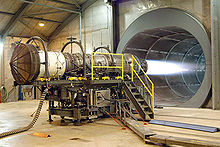Rhenium
With an estimated average concentration of 1 part per billion (ppb), rhenium is one of the rarest elements in the Earth's crust.
It resembles manganese and technetium chemically and is mainly obtained as a by-product of the extraction and refinement of molybdenum and copper ores.
It was rediscovered in 1925 by Walter Noddack, Ida Tacke and Otto Berg,[10] who gave it its present name.
[11] Nickel-based superalloys of rhenium are used in combustion chambers, turbine blades, and exhaust nozzles of jet engines.
Because of the low availability relative to demand, rhenium is expensive, with price reaching an all-time high in 2008–09 of US$10,600 per kilogram (US$4,800 per pound).
Element 113 was also discovered by a team of Japanese scientists and was named in respectful homage to Ogawa's work.
[19][20] The original mischaracterization by Ogawa in 1908 and final work in 1925 makes rhenium perhaps the last stable element to be understood.
Its usual commercial form is a powder, but this element can be consolidated by pressing and sintering in a vacuum or hydrogen atmosphere.
[27] Rhenium has one stable isotope, rhenium-185, which nevertheless occurs in minority abundance, a situation found only in two other elements (indium and tellurium).
A kilogram of natural rhenium emits 1.07 MBq of radiation due to the presence of this isotope.
[35] The structures of these compounds often feature extensive Re-Re bonding, which is characteristic of this metal in oxidation states lower than VII.
Like tungsten and molybdenum, with which it shares chemical similarities, rhenium forms a variety of oxyhalides.
[38] Dirhenium decacarbonyl can be oxidised with bromine to bromopentacarbonylrhenium(I):[39] Reduction of this pentacarbonyl with zinc and acetic acid gives pentacarbonylhydridorhenium:[40] Methylrhenium trioxide ("MTO"), CH3ReO3 is a volatile, colourless solid that has been used as a catalyst in some laboratory experiments.
It can be prepared by many routes, a typical method is the reaction of Re2O7 and tetramethyltin: Analogous alkyl and aryl derivatives are known.
[43] Chile has the world's largest rhenium reserves, part of the copper ore deposits, and was the leading producer as of 2005.
[35] Total world production is between 40 and 50 tons/year; the main producers are in Chile, the United States, Peru, and Poland.
[51][52] The metal form is prepared by reducing ammonium perrhenate with hydrogen at high temperatures:[33] There are technologies for the associated extraction of rhenium from productive solutions of underground leaching of uranium ores.
Rhenium can cause superalloys to become microstructurally unstable, forming undesirable topologically close packed (TCP) phases.
[61][62] For 2006, the consumption is given as 28% for General Electric, 28% Rolls-Royce plc and 12% Pratt & Whitney, all for superalloys, whereas the use for catalysts only accounts for 14% and the remaining applications use 18%.
[56] The rising demand for military jet engines and the constant supply made it necessary to develop superalloys with a lower rhenium content.
[68] The high temperature stability, low vapor pressure, good wear resistance and ability to withstand arc corrosion of rhenium are useful in self-cleaning electrical contacts.
[55] Rhenium has a high melting point and a low vapor pressure similar to tantalum and tungsten.
[71] Rhenium in the form of rhenium-platinum alloy is used as catalyst for catalytic reforming, which is a chemical process to convert petroleum refinery naphthas with low octane ratings into high-octane liquid products.
[73] Rhenium catalysts are very resistant to chemical poisoning from nitrogen, sulfur and phosphorus, and so are used in certain kinds of hydrogenation reactions.
This is useful for radiopharmacy, where it is difficult to work with technetium – especially the technetium-99m isotope used in medicine – due to its expense and short half-life.
[81] Its high density, mechanical stability and corrosion resistance characteristics[82] ensure the equipment's durability and precise performance in demanding conditions.
[83] Rhenium is used in aerospace, nuclear, and electronic industries, and it shows potential for application in medical instrumentation.
The perrhenate had an LD50 value of 2800 mg/kg after seven days (this is very low toxicity, similar to that of table salt) and the rhenium trichloride showed LD50 of 280 mg/kg.



9 .



